Welcome back to another edition of the Lead Capture Blueprint, where we dive into real-world examples from the trenches of the lead gen world, to see what’s working and what you can apply to your own lead capture strategy.
This week, we’re digging into Ethos Life Insurance.
Even if you’re not in the insurance space, what Ethos is doing is worth studying, especially if you’re in a regulated industry where you need to ask many questions. From their ads, to their landing pages, to their multi-step forms, there are lessons here that apply to anyone running paid traffic and capturing leads.
Ethos’ Facebook Ads
Ethos is all over the place right now. Facebook, Google, Twitter, you name it.
What really makes their ads stand out is the simplicity and emotional resonance. Instead of talking about policies, premiums, or underwriting, they go straight for identity-driven hooks like:
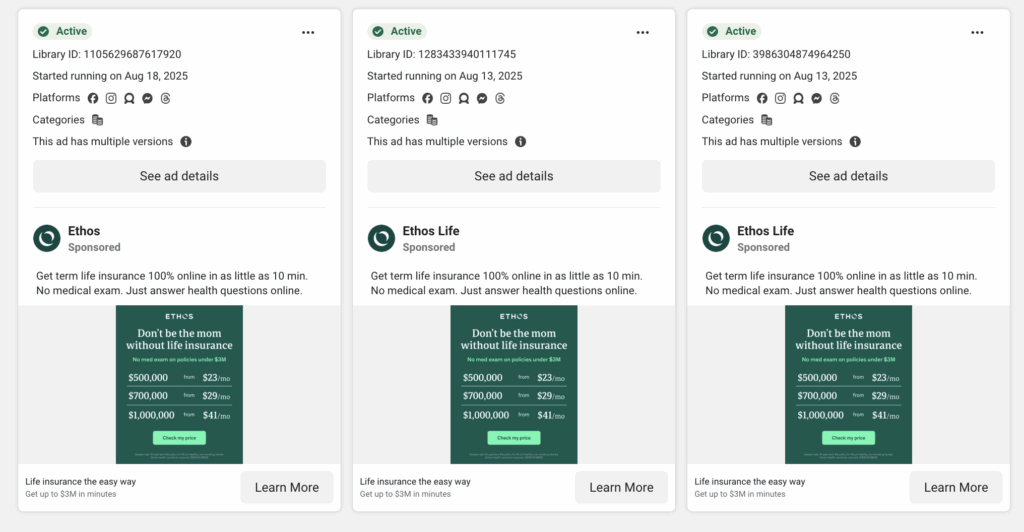
- Be the dad with life insurance
- Be the mom with life insurance
- In your 50s? Get covered in minutes
They pair these with UGC-style content that feels more like a friend’s post than a polished corporate ad. It’s a smart move in a market where trust and relatability are everything.

As a dad myself, I’ll admit the “Be the dad with life insurance” line stopped me mid-scroll. The design wasn’t groundbreaking, but the message was powerful. That’s what good targeting and message match looks like.
Their Mobile Optimized Landing Page
Since Ethos is running Facebook Ads, most of their traffic is probably mobile. So let’s focus on the mobile experience.
When you click through from the ad to the landing page, you’ll see how well they carry the message through, with a simple visual of a happy family.
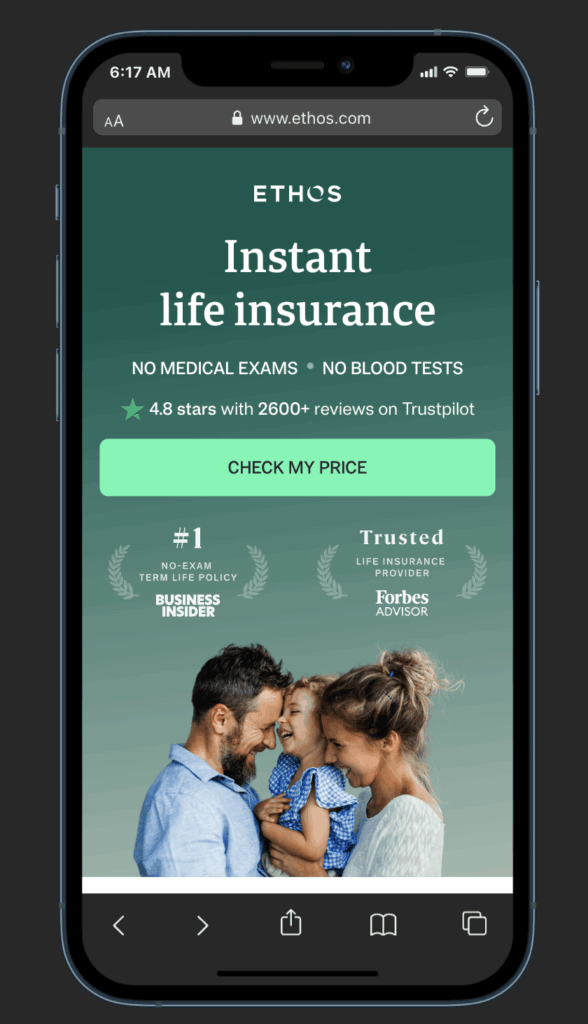
Here’s the desktop view:
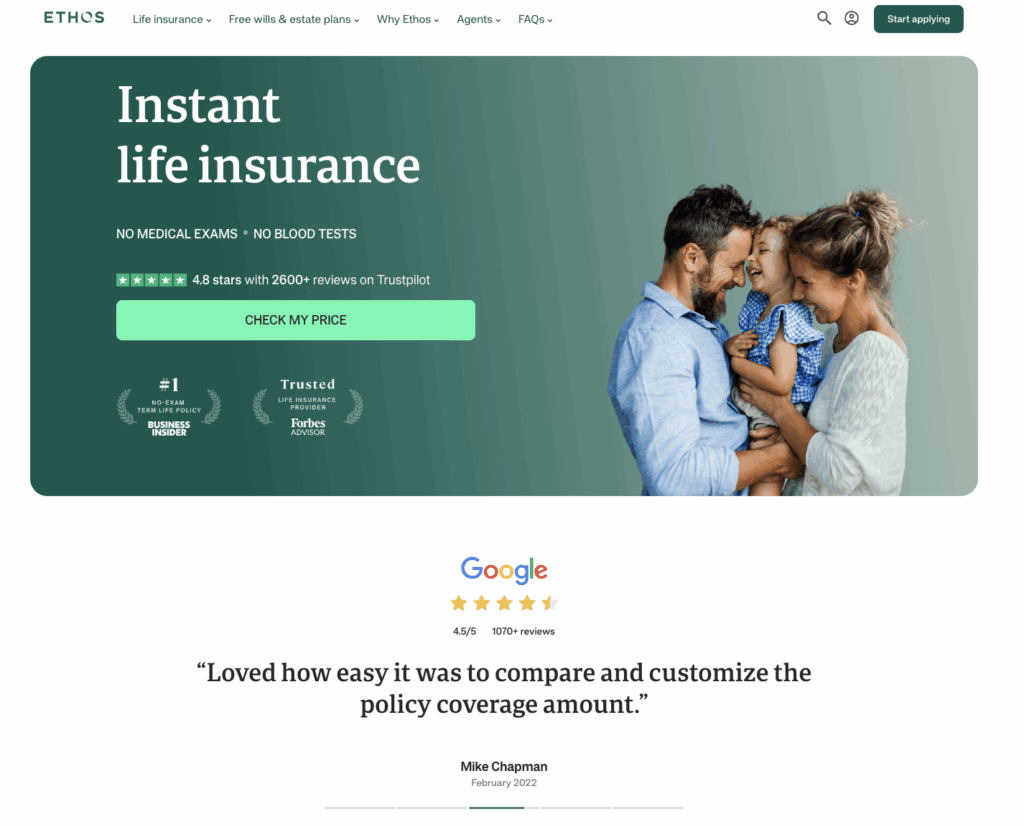
Overall, this is a well-optimized hero image setup, with a responsive, CDN-delivered image, prioritized for quick load, and non-blocking decoding. Simply meaning that they have it loading fast.
I also want to point out how simple the page is:
- Headline: “Instant Life Insurance” — So this way you know you’re in the right place
- Visual: A family photo that mirrors the ad
- CTA: “Check my rates”
- Then some social proof below.
There are three things I want to highlight here:
First, it’s all about congruence. The closer the ad and landing page line up, the higher the chance the visitor keeps moving forward.
Second, the CTA is low friction and engaging. “Check my rates” feels fast, personal, and safe. Compare that to “Get a quote” or “Talk to an agent,” which sound slow and high-commitment. That single change lowers friction dramatically.
Finally, I want to call out how Ethos is keeping the page and design simple. It’s fast, it gets to the point, and it keeps the prospect focused on that next step. If you’re overthinking your landing pages and forms from a design perspective, then you’re already behind companies like Ethos who are moving fast.
The Multi-Step Lead Form: Tapping into Powerful Emotional Triggers Early On
Now here’s where things get really interesting. Ethos is running a long, multi-step form, but they use psychology to keep people engaged.
They open with goal-based questions:
- “What are your goals for life insurance?” (Protect loved ones, pay off mortgage, prepare for family’s future).
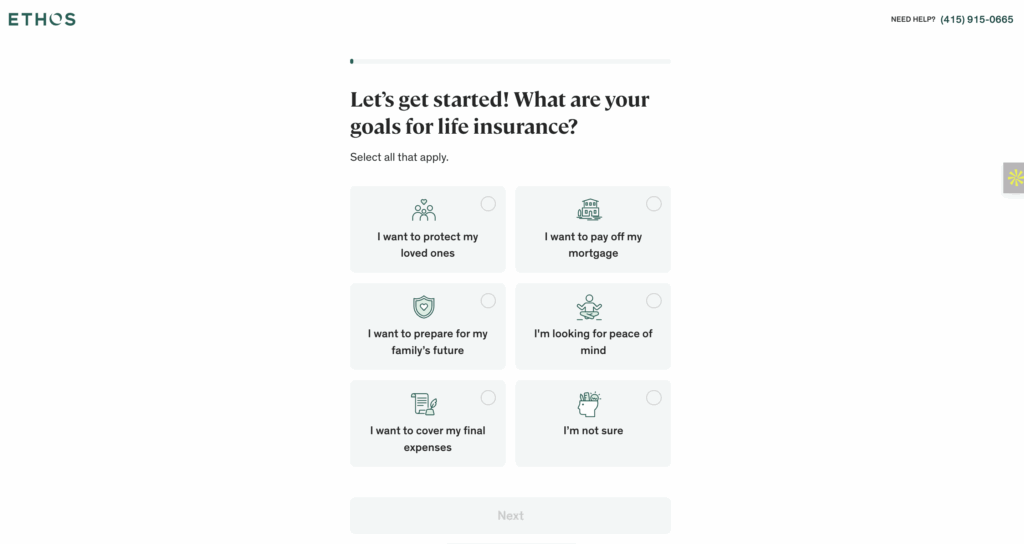
By the way, this type of setup where it’s just the logo, the lead form, and maybe some social proof is what we see converting the highest at LeadCapture.
Now, here’s where things get really interesting. After the first question, Ethos moves into emotional framing:
- “Who depends on you financially?”
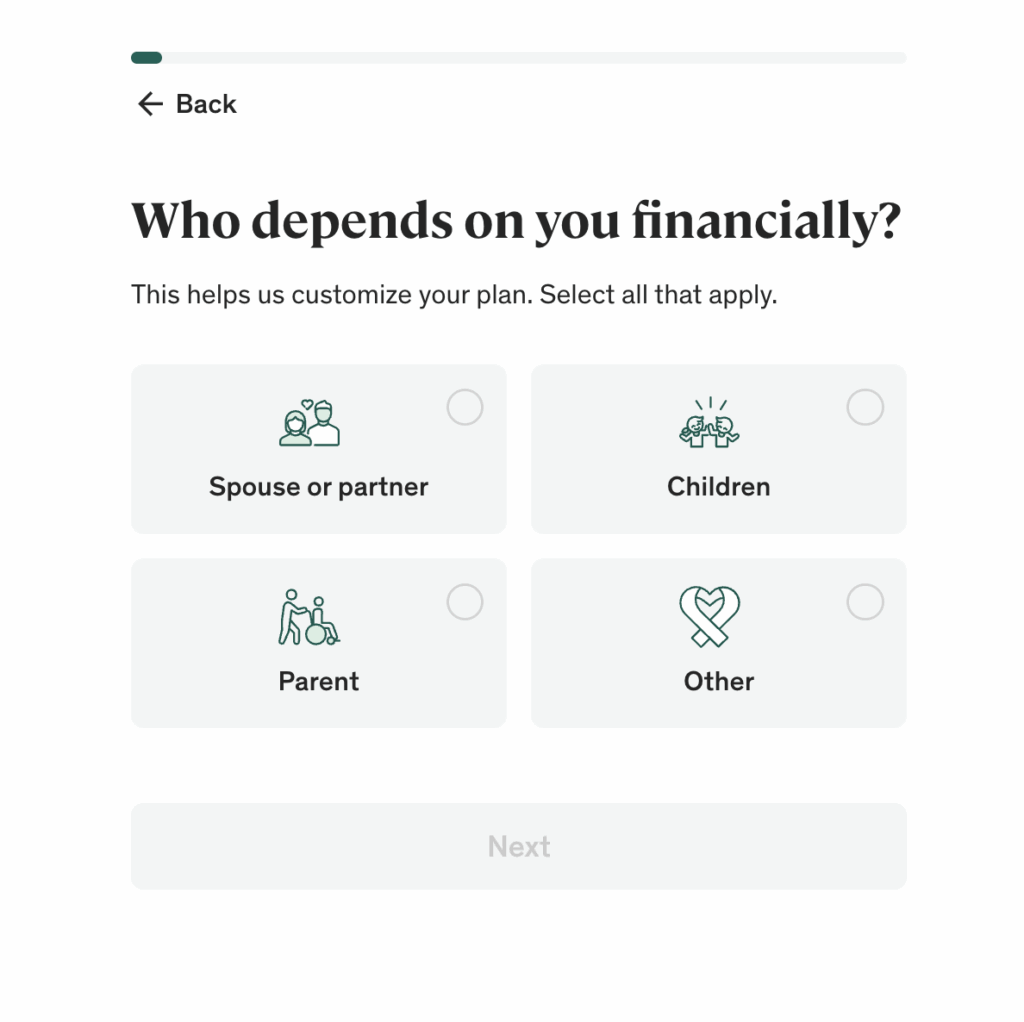
That question is powerful. It gets the prospect thinking about their kids or spouse and primes them to keep going. Once you’re emotionally invested, you’re more likely to push through the longer form.
Why this works psychologically
This is a great example of moving prospects out of what some like to call “monkey brain mode”… the instinctive, autopilot part of the brain that resists giving away personal details, and into the prefrontal cortex, the part responsible for empathy, planning, and higher reasoning.
By asking prospects to pause and picture the people who rely on them, Ethos reframes the form. It’s no longer about filling out boxes on a screen. It’s about protecting loved ones. That shift is incredibly sticky. Once someone has made that mental leap, they’re far more likely to follow through, even if the form has 10 or 20 more steps.
This ties directly to the research of neuroscientist Antonio Damasio, author of Descartes’ Error: Emotion, Reason, and the Human Brain.
Damasio showed that emotions are inseparable from rational decision-making. Without activating the emotional centers first, the prefrontal cortex struggles to evaluate choices effectively. In other words, a well-timed emotional question doesn’t just make a form feel more human, it literally primes the brain to engage in thoughtful decision-making.
Why you should test emotional trigger questions early
If your forms are purely transactional from the start, “What’s your name?” “What’s your email?”, etc… you’re not giving the brain any reason to stay engaged. You’re just feeding the instinct to get out of the form as quickly as possible.
But if you open with an emotional anchor, you can prime prospects to continue. Even one well-placed question can shift the mindset from resistance to commitment.
That’s why I recommend experimenting with emotional trigger questions early in the flow. They set the tone, activate the right part of the brain, and make every question that follows feel more purposeful instead of transactional.
Other smart touches
- Sliders with smart defaults (starting at common coverage levels instead of zero).
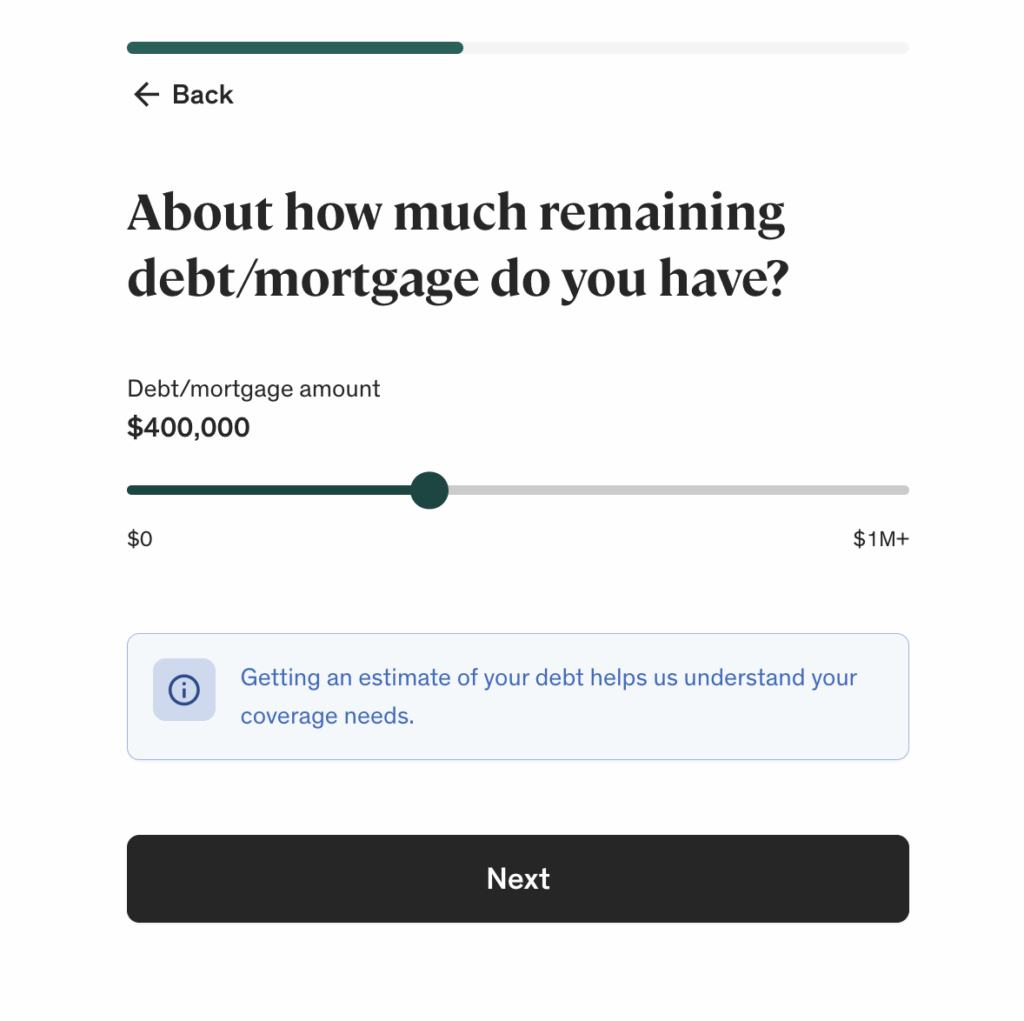
- Helper text for longer sections to reduce drop-offs.
- A testimonial in the middle of the form to build trust.
- Qualifying questions around nicotine use, estate planning, and mortgage debt, which likely feed both compliance needs and cross-sell opportunities.
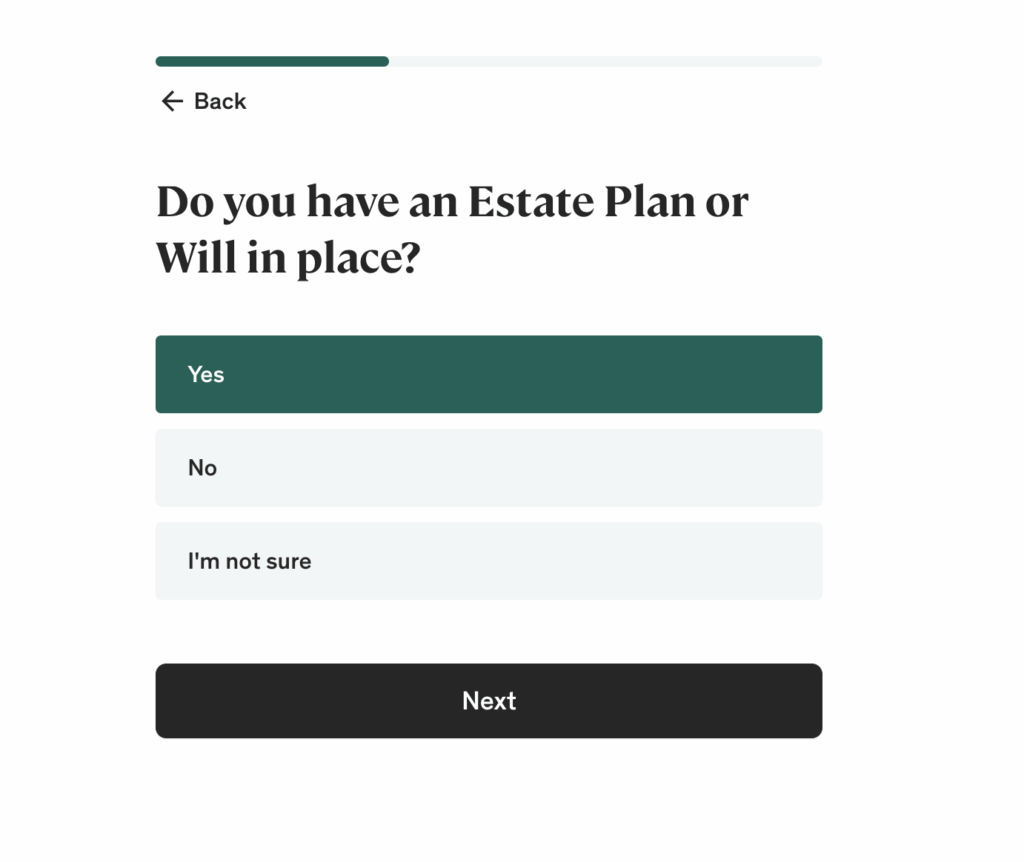
This is exactly the type of approach we see converting best in regulated industries. Multi-step forms strike the balance between gathering enough qualifying data and keeping the user moving forward.
Where They Fell Short
Near the final step, I hit a wall. The form blocked me with no explanation when I went to enter my email.
I’m not sure if I was disqualified at some point based on my answer or an underlying datapoint that I couldn’t see like IP address, or if my email was coming back invalid, although I didn’t get any sense that they were validating my email address in the lead form like LeadCapture allows for.
But either way, this is a huge miss and point of confusion for me in their funnel. You can build the perfect funnel, but one small error can sink ROI.
Lessons
- Lead with emotion. Identity-driven hooks outperform transactional ones.
- Keep ad → landing page → form aligned for maximum relevance.
- Lower CTA friction. “Check my rates” is a great example.
- Use emotional trigger questions early. Get prospects out of autopilot and into commitment mode.
- Multi-step forms outperform single-step in regulated industries.
- Test your flow end-to-end. Small glitches create confusion, and confusion kills conversion
To wrap, Ethos shows how psychology and form design work together to convert and capture cold leads directly from Facebook Ads. If you’re not testing emotional priming in your own lead forms, this might just be your sign to take a page out of Ethos’ book. That’s the LeadCapture Blueprint for this week, until next time — John
Already a LeadCapture customer (or thinking of becoming one) and want extra help? If you’ve been on the fence or need help managing everything, click reply to ask us about our fully managed service where we work behind the scenes setting up your lead forms, ensuring everything is running smoothly and providing ongoing conversion analysis and testing to help improve performance.
Join the free Lead Capture Community: Network with other lead pros, get behind-the-scenes insights, and level up your lead gen game. It’s free! Request access here: https://hq.leadcapture.io
Book a strategy session and demo: Want to see Leadcapture.io in action and learn how it can help you? Book a strategy session here. https://leadcapture.io/demo or start a trial here https://app.leadcapture.io/trial

